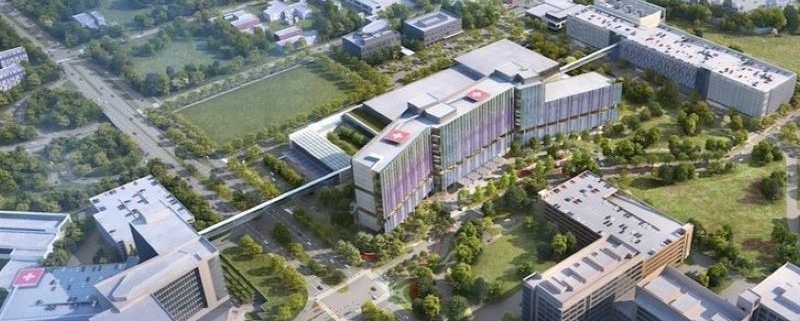Children’s Health and UT Southwestern Medical Center are in the planning stages of a new pediatric campus in Dallas.
The two entities estimated a $1.6 billion construction budget and a total project cost of $2.5 billion, according to original solicitation documents obtained by D CEO Magazine. (The project was first reported last year by the website Strategic Partnerships Inc., which follows large procurement projects across the country.)
The hospitals released the solicitation documents seeking contractors in January 2022 and had a goal of completing the project by 2028, according to the original solicitation.
“The University of Texas Southwestern Medical Center and Children’s Health System of Texas, on behalf of the Joint Pediatric Enterprise, are soliciting statements of qualifications for selection of an Architect/Engineer firm for the New Pediatric Campus,” the executive summary reads.
The documents describe a new pediatric hospital with 532 beds, an emergency department with 90 bays, more than 90 newborn intensive care unit beds, and services to support a new labor and delivery program with approximately 30 beds. Neither health system responded to an email requesting confirmation of those specifics. Because the project is in its early stages, the specs are likely to change. The existing Dallas main campus has 490 beds.
In an internal email to UT Southwestern staff last fall, President Dr. Daniel Podolsky mentioned the new campus among other developments in the works at UTSW.
Dr. Podolsky wrote: “The planning for the new pediatric campus will accelerate as our joint pediatric experience enables our two organizations to work together to provide care to children and support their families. The new hospital and expanded ambulatory services will advance our pediatric care strategic plans and strengthen our longstanding partnership with Children’s.”
An agreement with a vendor was supposed to have been executed last May, and an 18-month planning and design process was set to commence last June. According to the UT Southwestern supplier bid portal, that RFQ has been awarded. A UT Southwestern spokesman did not respond to an email requesting comment on “design and other related services for a new children’s hospital in Dallas” on Monday.
Children’s Health and UTSW released a joint statemen that read: “Our joint pediatric enterprise is always pursuing opportunities to bolster capacity to provide care in response to record population growth and demand for pediatric specialty services in North Texas. To meet these needs, we are exploring a possible new pediatric campus. Specific details on a project of this magnitude are not final, or approved, and may not be for some time. We look forward to sharing accurate, finalized, information with the community if it is approved by both our institutions and associated boards.”
According to the original timeline in the documents, “schematic design documents” were supposed to be presented to the Board of Regents for approval next month. Final “design development documents” were to be submitted to the regents in August, and construction was originally planned to begin next year. A new timeline for the project was not immediately available.
The original solicitation documents also say that the new facility is set to replace all the services offered in the current hospital and bring services from other facilities to the new campus. The project description included plans for a new master plan for the campus, an administrative building for clinical and support staff, an ambulatory care facility with 250 exam rooms, a utility plant to support the campus, at least one parking garage with 6,500 spaces, and other infrastructure elements. Whether these details make it into the final plans is yet to be determined.
Children’s Health was founded in 1913, growing and expanding into its location in 1967 with 130 beds. In 2008, Children’s approved the construction of a campus in Plano, which now has 72 beds. In 2014, the organization rebranded to Children’s Health. It currently serves 800,000 visits annually.
The hospital is unlikely to be built in the exact location of the existing campus to avoid any interruptions in service, but the joint venture with UTSW makes the new site likely to be located somewhere in the Medical District. The area has several open spaces, especially north of the current campus near Inwood Boulevard and Harry Hines Boulevard. Final design plans have not yet been approved.
The Medical District has been bustling with construction projects. In December, the state broke ground on a new psychiatric hospital across the street from the Children’s Health Dallas. The project received $282.5 million from the state, and Children’s Health donated $200 million to support a pediatric psychiatric wing. It will have 296 beds, with 96 reserved for children. That state hospital is set to finish construction in 2025.
A Texas Public Information Act request to review documents related to the new pediatric hospital submitted has yet to be fulfilled by UT Southwestern.
Source: D CEO Magazine





